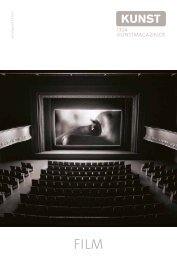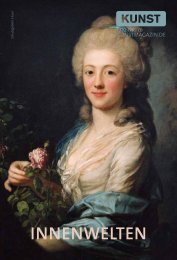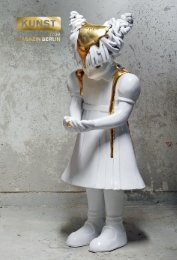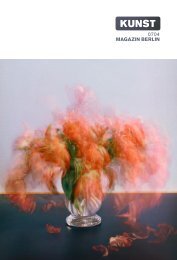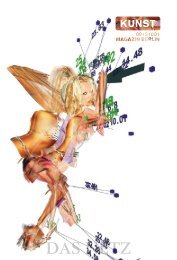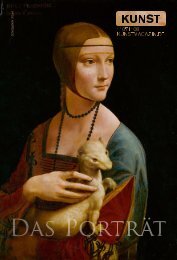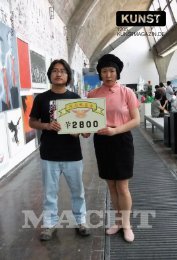Download als .pdf - KUNST Magazin
Download als .pdf - KUNST Magazin
Download als .pdf - KUNST Magazin
Erfolgreiche ePaper selbst erstellen
Machen Sie aus Ihren PDF Publikationen ein blätterbares Flipbook mit unserer einzigartigen Google optimierten e-Paper Software.
Galerieprofil Alexander Levy: Offene Türen<br />
Gallery Profile Alexander Levy: Open Doors<br />
Text: Julika Nehb Translation: Brian Poole<br />
Ein schmaler Aluminiumstab ragt aus der Fassade<br />
der Rudi-Dutschke-Straße 26 – etwa einen Meter<br />
lang, schräg nach oben, auf der Höhe des ersten<br />
Geschosses. Ein zufällig nach oben geworfener Blick<br />
gibt Rätsel auf. Was soll das? Wo kommt dieser Stab<br />
her? Auf der Suche nach seinem Ursprung kann<br />
architektonische Schlamperei schnell ausgeschlossen<br />
werden: Er sticht aus den Räumen der Galerie des<br />
jungen Hamburgers Alexander Levy heraus. Bis zum<br />
14.7. läuft hier die Ausstellung „Tür und Stern“.<br />
Dort hat der 31-jährige Berliner Künstler Felix<br />
Kiessling in seiner Arbeit „Superstern“ drei<br />
identische, mehrere Meter lange Aluminiumstäbe<br />
in einem Vektorkreuz zusammengeführt. Sie weisen<br />
in sechs Richtungen und beschreiben mehrere<br />
denkbare unendliche Räume. Der Künstler legt<br />
gewohnte Erfahrungswerte und Denkmuster offen<br />
– wie etwa die Vorstellung von Raum: oben und<br />
unten, drinnen und draußen, vier Wände, und am<br />
besten ist alles schön rechtwinklig? Durch eine<br />
einfache, aber wirkungsvolle Manipulation kippt<br />
Kiessling diese Konventionen um. Der „Superstern“<br />
hat sein Zentrum nicht im Mittelpunkt des<br />
Raums, und die Aluminiumstäbe – Sinnbild dieses<br />
Koordinatensystems – verlaufen eben gerade nicht<br />
parallel zu den Raumkanten des Gebäudes. Sie<br />
verlaufen diagonal und nehmen keine Rücksicht<br />
auf künstliche Begrenzungen. Einer piekst von oben<br />
schräg nach unten durch eine Trennwand und den<br />
Fußboden, ein anderer durchbohrt einfach eben mal<br />
die Fassade.<br />
Kiessling setzt seinen formal reduzierten,<br />
spielerischen Ansatz in drei weiteren Arbeiten fort.<br />
In zwölf kleinformatigen Fotografien inszeniert<br />
er durch ungewöhnlich platzierte Aluminium-<br />
Vektoren außergewöhnliche Blickwinkel. Diesmal<br />
nicht in geschlossenen künstlichen Räumen, sondern<br />
in der freien Landschaft, in Frankreich, Spanien<br />
oder im Brandenburgischen. Auf einer Fotografie<br />
scheint es, „<strong>als</strong> wäre dem Meer der Stöpsel gezogen<br />
worden“, wie Galerist Alexander Levy formuliert.<br />
Sehr abstrakt wird es bei einer Wandarbeit, die das<br />
Planetensystem beschreibt und an die Grenzen der<br />
menschlichen Vorstellungskraft erinnert. Von hier<br />
aus fällt der Blick auf die vielleicht imposanteste<br />
Arbeit der Ausstellung: 22 Altbautüren, die Kiessling<br />
aus Berliner Bauruinen zusammengetragen hat<br />
und nun in einem weiteren Raum präsentiert. Die<br />
meisten lehnen an der Wand, teilweise voreinander<br />
gestapelt, manche schweben, an unsichtbaren<br />
Fäden aufgehängt. Während die anderen Arbeiten<br />
das abstrakt-physikalische Gedankenspiel über die<br />
verschiedenen Möglichkeiten, Räume zu denken,<br />
eher formal behandeln, verdichtet Kiessling mit der<br />
mit „Tür und Vektor“ betitelten Arbeit sein Thema<br />
durch die zeitliche Dimension auch historisch:<br />
Welche Räume öffneten diese Türen? Was spielte<br />
sich in ihnen ab? Wurden manche von ihnen wütend<br />
zugeworfen, und wenn ja, warum?<br />
A small aluminium bar juts out from the façade of<br />
the building at 26 Rudi-Dutschke Strasse. It’s about<br />
a metre long, extending upwards at the height of<br />
the first floor. Those who happen to look up at it<br />
find it puzzling. What’s that all about? What’s the<br />
bar doing there? A closer look reve<strong>als</strong> that it can’t<br />
be the result of an architectural muddle. It juts out<br />
of the rooms of the gallery operated by Alexander<br />
Levy, who hails from Hamburg. Here the exhibition<br />
“Tür und Stern” (“Door and Star”) will be running<br />
until the 14th of July.<br />
In his work “Superstar” the 31-year-old Berlin artist<br />
Felix Kiessling has constructed a vector intersection<br />
using three identical aluminium bars of several metres’<br />
length. They point in six different directions and<br />
describe a number of possible infinite spaces. The artist<br />
uncovers our habitual empirical values and thought<br />
patterns—among them the perception of space. We are<br />
accustomed to expect a top and bottom, an inside and<br />
out, and four walls, all typically right-angled. But with<br />
a simple yet effective manipulation, Kiessling topples<br />
these conventions. The “Superstar” has its centre in the<br />
middle of the room. The aluminium bars—the image<br />
of a system of coordinates—do not run parallel to the<br />
contours of the building. Rather, they run diagonally<br />
to them, and thus pay no heed to artificial limitations:<br />
one bar stabs downward from above, passing through<br />
a dividing wall and the floor; another simply bores its<br />
way through the façade.<br />
Kiessling continues his formally reduced and playful<br />
method in three other works. In 12 small format<br />
photographs he stages highly exceptional angles<br />
using oddly positioned aluminium vectors, this time<br />
not in closed artificial space but in the open outdoor<br />
landscape of France, Spain and Brandenburg. In one<br />
photograph it seems “as though the plug had been<br />
taken out of the ocean,” says the gallerist Alexander<br />
Levy. A very abstract mural work depicts the<br />
planetary system, reminding one of the limitations<br />
of human imagination. From thence our glance<br />
falls upon the perhaps most imposing work at the<br />
exhibition: Kiessling has collected 22 anti-bellum<br />
doors from Berlin’s construction ruins; now they are<br />
being presented in another room at the gallery. Most<br />
of them are leaning against the wall, some doors are<br />
leaning against others, and still others float in the air,<br />
suspended by invisible threads. Whereas the other<br />
works treat rather formally the abstract physical play<br />
of thoughts concerning the various ways of conceiving<br />
of space, in the work entitled “Door and Vector”<br />
Kiessling concretises his theme by adding a historical<br />
dimension to the temporal one. What rooms do these<br />
doors open to? What has transpired behind them?<br />
Have some of them been slammed shut in anger; and,<br />
if so, why?<br />
“Space is a continuously changing simultaneity of<br />
earlier histories.” This is a thought that Kiessling’s door<br />
work closely approaches. The notion was advanced by<br />
Olafour Eliasson, director of the Institute for Space<br />
12 GALERIEPROFIL<br />
GALERIEPROFIL 13



